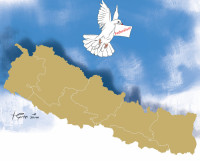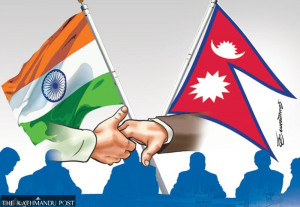Columns
Human capital first
Nepal’s key strength lies in harnessing its human capital in knowledge-driven sectors.
Dilasha Joshi & Prabesh Rijal
Nepal’s landlocked status and logistical hurdles have created deep trade inefficiencies, worsened by its reliance on India for access. As the global economy shifts towards a ‘weightless and borderless’ model driven by ideas and technology rather than the physical form of products, Nepal has a chance to bypass these limitations. A knowledge-based economy—spanning agri-tech to digital services—can unlock new growth. Estonia’s e-governance and Rwanda’s tech innovation show how even resource-scarce nations can thrive by leveraging human capital and digital infrastructure.
Nepal’s heavy reliance on remittances and labour exports—mostly unskilled—raises serious questions about long-term sustainability and equitable progress. While remittances amount to around 26 percent of the GDP, they largely fuel consumption rather than productive investment. Traditional sectors like the carpet industry are experiencing a downturn. Meanwhile, a significant portion—around 54 percent—of the labour we send overseas is unskilled. This not only leads to a loss of human potential but also undermines our ability to strengthen the workforce at home.
As per Nepal Rastra Bank, an estimated 82 percent of Nepal’s total merchandise export earnings are offset by students’ spending abroad, leading to a double blow: Financial drain and brain drain. As a country facing high trade costs, fragile supply chains and declining export competitiveness, Nepal cannot build a strong future on physical goods alone. With our demographic window open only until 2047, the time to act is now. Investing in human capital, advanced skills and innovation is essential to seize this opportunity.
Emerging knowledge-based sectors
Nepal doesn’t need to imagine a knowledge economy—it already exists in pockets of excellence. Tilganga Eye Hospital is one such success story. Founded by Dr Sanduk Ruit, Tilganga has become a global symbol of Nepali medical innovation. By simplifying cataract surgery and producing low-cost intraocular lenses (IOLs), Tilganga has restored sight to hundreds of thousands across Asia and Africa. These lightweight, easily exportable lenses showcase the “weightless and borderless” nature of knowledge-based trade. With many diaspora Nepalis returning for affordable care, ranging from eye surgeries to dental procedures and full-body checkups, Tilganga also hints at the untapped potential for Nepal in medical tourism. If replicated across other health sectors, this model could help Nepal emerge as an exporter of specialised healthcare services.
Another emerging pillar of the economy is the Information Technology sector. As per a study by the Institute for Integrated Development Studies (IIDS), the IT sector currently contributes around 2 percent to the GDP, indicating that IT exports reached $515 million in 2022. The government has set an ambitious target to achieve Rs3 trillion in exports of goods and services from the IT sector over the next 10 years. Companies like Fusemachines (AI), SecurityPal (cybersecurity) and Incessant Rain Studios (VFX and animation) are proving that Nepal can compete globally in high-value digital services. Similarly, startups like Gham Power show how innovation can address local challenges, using solar and digital solutions to build climate resilience in Nepali communities.
Bedrock of knowledge economy
Education is a bedrock of the knowledge economy. It is the engine of human capital. But that engine is sputtering in Nepal. In primary education, learning poverty remains a major concern. According to the National Assessment of Student Achievement (NASA) (2020) report, only 43.5 percent of Grade 3 students meet reading benchmarks, and just 37.2 percent reach the expected level in mathematics. By Grade 8, only 32.1 percent demonstrate basic math proficiency and 37.7 percent in science. These figures point to deep-rooted inefficiencies, suggesting that schooling in Nepal has too often been a wasted opportunity.
The issue of retention and pass percentages is severe. Of the nearly 928,000 students who started Grade 1 in 2015, less than half (45 percent) reached the 2024 SEE exam. In 2024, over 52 percent of students in the Secondary Education Examination (SEE) were ungraded, and 47 percent failed the Grade 12 (+2) exam. On tracking the cohort that started Grade 1 in 2011, only 15 percent regularly passed Grade 12 in 2024, indicating a major dropout over the years. This funnel of failure is not just alarming—it is a national emergency threatening the future of Nepal’s knowledge economy.
The university sector is also facing significant challenges. According to the Education Management Information System (EMIS) report 2023-24, although Nepal has 12 central and 4 provincial universities, Tribhuvan University alone accounts for 78 percent of total university enrollment. This concentration has led to structural inefficiencies, encouraging generalisation rather than specialisation, and increasing political influence due to its dominant share. In university education, enrollment rose by 75.3 percent from 2015–16 to 2023–24, but graduates increased by only 7.9 percent. This gap highlights poor course relevance and a growing trend of students leaving the country before completing their studies. Even for those who remain, many are not gaining relevant skills.
Only 17 percent of students are enrolled in STEM fields, even though global demand for STEM jobs is growing three times faster than for non-STEM roles. The problem also extends to the Council for Technical Education and Vocational Training (CTEVT). Despite the wide range of programmes offered by CTEVT, actual enrollment and graduation rates are falling, especially in key sectors like engineering, nursing and dental. This leaky pipeline worsens with a massive student exodus—over 336,000 NOCs issued in three years from 2020-21 to 2022-23, averaging 110,000 annually, while only 97,564 students graduate each year.
From education to innovation
Improving long-term learning outcomes in Nepal requires bold policy reform. Investing in foundational cognitive skills, addressing disparities and scaling timely interventions—like remedial classes—are vital to support struggling students. To thrive in a global knowledge economy, Nepal must reimagine education by establishing specialised institutions (like India’s IITs, IIMs) and Centres of Excellence in TVET that are aligned with industry needs. Modernised curricula should emphasise STEM, digital skills and problem-solving, with strong industry-academia ties.
English proficiency is another critical factor. In 2023-24, only 7 percent of Nepali IELTS test-takers scored a band 7 or higher, compared to higher rates in the Philippines (9 percent), Malaysia (12 percent) and India (17 percent). Strengthening English language education through improved curricula, peer-assisted learning and volunteer-based language support programmes can significantly enhance global employability for Nepali graduates. Research, innovation and startup-friendly policies should be central to this transformation. Nepal must also move beyond the outdated, exam-centric model. A knowledge economy cannot be built by discarding its most valuable resource—the curious, untapped minds.
Conclusion
Nepal’s key strength lies in harnessing its human capital in knowledge-driven sectors. This shift can boost its soft power through innovation and expertise. Its global diaspora is a valuable asset, enabling knowledge transfer, entrepreneurship and international collaboration. Nepal ranks 25th out of 27 countries in the Asia Power Index 2024, a comprehensive measure of the relative power of states in Asia based on their resources and influence.
To advance, Nepal must invest in a knowledge-based economy by strengthening education, research and technology. This requires aligned reforms and sectoral strategies, with strong policy and institutional commitment to developing human capital and driving sustainable growth.




 10.12°C Kathmandu
10.12°C Kathmandu

.jpg&w=200&height=120)












%20(1).jpg&w=300&height=200)

